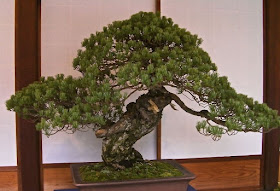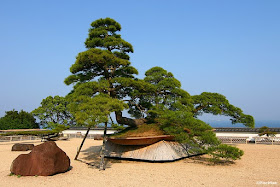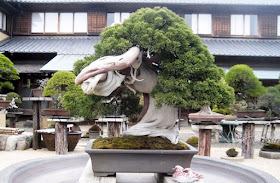As simple as it seems, it's not that simple to discover the oldest Bonsai's on earth. These are the ones that are known to public, the youngest tree is estimated to be 300 years and above. Not only the age of these astonishingly well kept trees is a challenge but also the upkeep. Can you imagine if a 500 years old tree just dies in front of your eyes ? That would be the ultimate disaster but thank god trees are quite resistant over time. If you have trees that are older than the ones listed below, please feel free to let me know. I will be happy to include your Bonsai on this list. I firmly believe that there must be even older ones somewhere in remote areas in China.
First and foremost before going too much into details, what makes it a Bonsai ?
A tree planted in a small pot is not a bonsai until it has been pruned, shaped, and trained into the desired shape. Bonsai are kept small by careful control of the plant's growing conditions. Only branches important to the bonsai's overall design are allowed to remain and unwanted growth is pruned away. Roots are confined to a pot and are periodically clipped. Bonsai may have a stylized or exaggerated form, but it is always reflective of the tree as found in nature. The appearance of old age is prized, and in fact, bonsai may live to be hundreds of years old. The living bonsai will change from season to season and from year to year requiring pruning and training throughout its lifetime. As time goes on, it will become more and more beautiful.
Bonsai, which is the Japanese art of growing small trees in containers, dates back to about the 6th century BCE. During this time period, Imperial embassy personnel and Buddhist students would travel to China and bring back container plantings called penjing (the ancient art of depicting artistically formed trees and landscapes in miniature).
One of the hallmarks of the art of bonsai is that with proper care, a tree can survive for many years and be passed down as a family heirloom. The following list covers the seven oldest bonsai trees in the world and their storied pasts.
Chabo-hiba Cypresses
Estimated: 275 years old
Location: Cambridge, Massachusetts, USA
Location: Cambridge, Massachusetts, USA
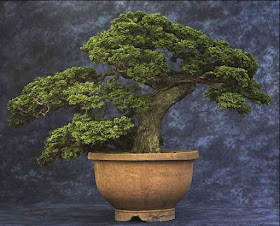 |
| Source: bark.com |
The Chabo-hiba Cypresses are a part of the Larz Anderson Collection of Japanese Dwarfed Trees at Harvard University’s Arnold Arboretum. Anderson, who served as an ambassador to Japan brought back a large collection of bonsai trees to the U.S. in 1913. After his death, his widow Isabel Anderson donated 30 plants to the Arnold Arboretum with the rest of the trees added to the collection after Isabel’s death in 1949.
The jewels of the collection are the six Chabo-hiba (hinoki cypress) trees, ranging in age from 150 – 275 years old. These trees are the oldest still living bonsai trees in America.
Yamaki Pine
395 years old
Location: Washington D.C., USA
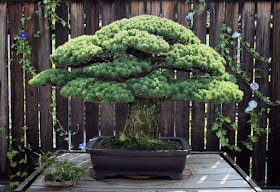 |
| Source: National Geographic |
In recent years, the Yamaki Pine has become one of the most famous bonsai trees in the world as its true history was uncovered in 2001. The bonsai tree, which has been residing in the U.S. National Arboretum, was donated to the United States by Masaru Yamaki in 1976 as a 53-specimen gift for the country’s bicentennial and is a survivor of the atomic bomb dropped on Hiroshima, Japan during World War II.
The National Arboretum was unaware of the bonsai tree’s history until two of Yamaki’s grandchildren came to check up on the tree in 2001. Yamaki’s grandchildren provided the museum with the tree’s history and even told them that there was news footage taken at the Yamaki Nursery after the blast showing the tree unharmed in the background.
In 2015, the National Arboretum honored the tree’s history as it was the 70th anniversary of the Hiroshima bombing.
Sandai Shogun no Matsu
500 years old
Location: Tokyo, Japan
The Sandai Shogun no Matsu, which is a five-needle pine, is one of the National Treasures of Japan. The bonsai is thought to be over 500 years old and is named for Shogun Tokugawa Iemitsu. Iemitsu had the tree when it was already about 200 years old and since then, the bonsai has been passed down from emperor to emperor.
This bonsai tree has been cared for by Japan’s emperors for over 500 years and today, the Sandai Shogun no Matsu is displayed in the Tokyo Imperial Palace collection.
The Atami Red Pine Bonsai
600 years old
Location: Atami, Japan
Yes, Bonsai can be large trees too. The red pine bonsai located at the Akao Herb & Rose Garden is not only one of the oldest bonsai trees, but it is believed to be the largest bonsai in the world. The tree is over 16 feet tall and over 30 feet wide and while its size is atypical for a bonsai, the red pine still qualifies as a bonsai tree as it is contained in what can technically be considered a pot.
The tree is so massive that a support had to be added in order to hold up one of its main branches.

The Shunkaen Bonsai Tree
800 years old
Location: Shunkaen nursery, Tokyo, Japan
The Shunkaen Bonsai Musuem, which is owned and operated by Kunio Kobayashi, is home to two of the oldest bonsai trees in the world, both of which are estimated to be over 800 years old.
Kunio Kobayashi is a bonsai master who has been practicing the art for over 30 years. Kobayashi opened the Shunkaen Bonsai Museum in 2002 to help spread Japanese culture, especially the art of bonsai and to exhibit the work done by him and his apprentices.
The Mansei-en Juniper Bonsai
1000 years old
Location: Omiya, Japan
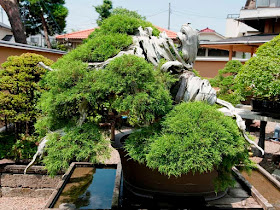 |
| Source: Bonsai Empire |
The 1,000 year old Juniper bonsai tree is located in the Mansei-en bonsai nursery which is owned by the Kato family. The Juniper tree was collected from the wilds of Japan and tested to be over 1,000 years old.
Mansei-en is one of six famous bonsai gardens that make up the Omiya Bonsai Village – it is the oldest garden located in the village as the Kato family has owned this garden since the 19th century and it was officially opened to the public in 1925. The garden is also home to old bonsai trees, including a 700-year-old Shimpaku Juniper tree (which can be seen in a picture on the website linked in this paragraph).
The Ficus Bonsai
1200 years old
Location: Parabiago, Italy
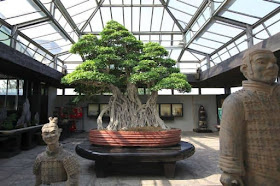 |
| Source: Bonsai dilettante |
The Ficus retusa Linn, which is found at the Crespi Bonsai Museum in Italy, is believed to be the oldest existing bonsai tree in the world at an estimated 1,000 years old. Luigi Crespi, the founder of the Crespi Bonsai Musuem, spent ten years trying to gain ownership of the bonsai tree and he succeeded in 1986.
The tree had previously been previously taken care of and shaped by Chinese masters and during its first years in Italy it was shaped by Japanese bonsai master Shotaro Kawahara. Crespi and Alberto Lavazza have since been taking care of the tree. Once the Crespi Bonsai Museum was founded in 1991, the tree was placed in a glass pagoda and became the centerpiece of the museum.
Interesting Books on Bonsai can be found here:
The Complete Book of Bonsai --> I've been into bonsai for 25 years and this is the basic Bible for beginner and intermediate bonsai enthusiasts. It has an excellent section on techniques, including pruning, wiring and whatnot, and it has a large species-specific tree guide. If you're into bonsai and want only one book, this is it.
Indoor Bonsai The Great Selection --> Creating beautiful, healthy bonsai is a wonderful skill that anyone can learn, with a little time, patience, and this all-inclusive manual. With color photos and drawings to illustrate the points, it introduces all the cultivation techniques; offers expert advice on location, soil types, watering, and pest control; and provides intricate instruction on training the bonsai--including pruning, wiring and stretching it.
The Secret Techniques of Bonsai --> In The Secret Techniques of Bonsai, the author of the groundbreaking Bonsai With American Trees teams up with his son to offer not only the basics for creating perfect bonsai, but also secret techniques they’ve developed over years of careful work and observation.
Bonsai Survival Manual --> Problem solving when your Bonsai get sick. Expand your gardening repertoire as you create a captivating and exquisite miniature world. In this introductory guide, Colin Lewis covers everything you need to know to design, grow, and successfully maintain attractive bonsai.
Bonsai and the art of Penjing --> Bonsai & Penjing, Ambassadors of Beauty and Peace describes how Chinese penjing and North American bonsai were later added to the Museum, making its collection the most comprehensive in the world. Stories of individual trees and forest plantings are featured, as are the roles played by the skilled and talented creators of these living art forms people such as John Naka, Saburo Kato, Yuji Yoshimura, Harry Hirao, and Dr. Yee-Sun Wu.
Bonsai with Japanese Maples --> With their delicate foliage, seasonal color changes, and intricate pattern of branching, Japanese maples are among the most popular and suitable plants for bonsai design. In this long-awaited book, internationally renowned expert Peter Adams discusses both the specific horticultural needs of Japanese maples as bonsai subjects and illustrates proven techniques for creating and maintaining beautiful specimens.
The Modern Bonsai Practice --> The most current, useful information on growing Bonsai. Fresh, practical, definitive, comprehensive reference guide to the finest art of horticulture: growing miniature trees. Common sense bonsai answers separating myth from fact with depth and detail. Appropriate for both bonsai hobbyists and experienced practitioners.
More Bonsai articles can be found here:
Please click here for more information on --> Chinese Penjing Bonsai
Please click here for more information on --> The Origins of Bonsai
Please click here for more information on --> The Art of Saikei Bonsai
Please click here for more information on --> Japanese Tanuki Bonsai
Please click here for more information on --> How to Water a Bonsai
Please click here for more information on --> Bonsai Healing Methods
Please click here for more information on --> Bonsai Books Review
Thank you for visiting my blog and feel free to subscribe or leave your message at the comment section below. Please always remember, good feedback's or bad remarks, it doesn't matter!


